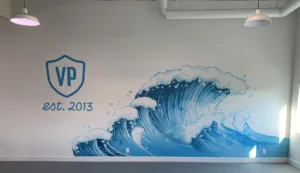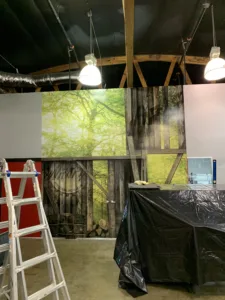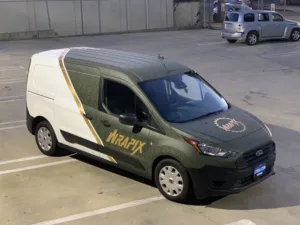The success of a project comes down to material choice. With numerous manufacturers to choose from, picking the right film can seem like an impossible task. If I simplify my options from what manufacturer to choose vs. what type of film to use, it makes it a little easier to find what I really need to make my project a success. No matter the manufacturer, you can break down vinyls into two categories: calendered films and cast films. But what does that mean? Those terms come from the process in which the material is made.
Calendered, sometimes referred to as “intermediate” films, are produced from a semi-solid and progressively rolled into the width and material thickness that gets delivered to us in our shops. Typically, this is why you will hear calendered film has a “memory,” meaning that this film eventually will try to return back to its original shape and size. This production is more cost-effective, which is why we typically see a lower cost when ordering these products.

Cast film, also called “Premium Films,” production is more of a liquid that is poured and cast into the width and thickness. You will hear cast film has “no memory,” meaning this film from its conception is the same shape and size that it comes off the roll. This will lead to a much more stable product over time, as well as give us the ability to manipulate the film better on installation. However, these benefits usually result in an increased cost on cast films.
The film differs in many ways other than just how it’s produced. Cast films are going to start around 2 mils in thickness whereas calendered start around 4 mils. This is for the base film only so once lamination is added the thickness doubles. It is also important to note that you always need to pair your base film with the matching laminates. Cast film must be laminated with cast overlaminates, and calendered films with calendered overlaminates. If you use a cast print film with a calendered overlaminate, you will lose all function of the cast film. In my training classes, I hear all the time, “calendered films are easier to apply.” Typically, it’s the thickness that installers are referring to, since calendered film is roughly 8 mils once laminated. The film is easier to handle once pulled off the liner.
How does the thickness of the film affect installs? Generally speaking, most people only consider this on installation of vehicle wraps. They opt for the Premium cast film because of the contours and the stretch of the film. We have found over the years that the thickness and the “memory” of calendered films has affected our film selection on interior wall graphics as much if not more than vehicle wraps.
Film choice for wall graphics
For many years on interior wall graphics, we would steer towards calendered films for many reasons, one being cost. These films, on average, were close to half the cost of cast films. With the typical amount of square footage that was being installed, the cost savings of calendered meant increase in profit and way less sticker shock (no pun intended) to the customer.

Location– these installs are located inside, and in our mind that meant why spend the extra money for a premium film with better exterior longevity when these graphics would never see the light of day.
Surface – the surface is flat and no need to stretch, so in reality, interior wall graphics check all the boxes of calendered, so that’s what we would use. We would notice the occasional lifting or seeing the edges of the graphics release a bit from the wall over time. Most of the time we blame the paint, adhesive, prep of the wall, and installation, all while overlooking our film selection.
As many of these can cause problems, I wanted to dig deeper and find each possible cause of a failed graphic so we could narrow down film selection for wall graphics. So, we ran tests on our own walls inside our shop. From calendered film to cast gloss finishes to matte finishes to latex and solvent prints, we tested everything. What we found is that even though walls look smooth, there is always a bit of texture. That texture can differ depending on the way it was painted; sprayed walls seemed to be smoother and have a tighter texture than the ones that were rolled.
The walls that were rolled depending on the type of roller would leave different types of texture. Installation of both cast and calendered films went down the same. We found that while printing on our latex printers, the lineup between panels on calendered films was more difficult than it was on cast. We found that lineup between the panels when printed with our solvent printers caused less of an issue with registration on calendered and cast films. We suspect that’s due to the increased amount of heat used to cure latex ink in the printing process.

Once the installs were completed, it was hard to tell what walls were wrapped in cast and what walls were wrapped in calendered, at least for the first couple weeks. Then, we started to notice the difference. The walls wrapped in cast still were showing the texture in the wall, whereas the walls wrapped in calendered seemed to look “smooth.” After a few weeks, we noticed the original texture we saw on installation of the calendered film had disappeared. The film was now “floating” on the high points of the texture. Over time, this got worse, causing the edges to lift and curl back, eventually resulting in the film failing to the point where the only fix would be reprinting and reinstalling the project.
Film choice for vehicle graphics
From simple spot graphics to partial and full wraps, from customers with one vehicle to hundreds, choosing the right film for the project is key. Full wraps are always going to be cast films, especially when you need to wrap bumpers or have any horizontal surface that is going to be wrapped such as hoods, roofs, and trunks. The cast film is going to wear better over the length of the project as well as conform better to the complex shapes like bumpers, mirrors, and door handles.

Partial wraps that are going to cover any complex contours or deep recesses should also be produced on cast films. Spot graphics on vehicles tend to lend themselves toward calendered films, especially when they are going to be on for a short period of time. Typically, we say less than two years at our shop as long as the placement for the graphics will only be on the vertical surfaces or the sides of the vehicle. The graphics will not see as much UV exposure and will tend to last that two year period.
The reason why we increase the time we allow calendered films to be on vehicles over wall graphics is due to the surface. The surface energy on vehicles is higher than a painted wall, and the adhesives will hold better for a longer period than they will on wall graphics.
This doesn’t mean we NEVER use calendered films. In fact, we use them quite frequently. So, how do we make the decision?
COST – this is where most people start, I know I used to. Over the years I’ve had to train myself to stop looking at the dollar amount of a roll and focus on more on the end goal, and this is how I start the process of picking a film. I have broken my material choice down to a couple steps to help me narrow the field when choosing a film.
TIME – This has to be the most important factor in our film choice. Whether it’s a wall or vehicle graphic, if the project is going to be up for more than year or two, we are going to use a cast film.
SIZE – The larger the project, the more we’re going to lean toward cast films. The reason behind this is I want the added security that we will run into less problems over time. With the cost of labor these days, it’s important to us that we never have to go back and fix an issue, especially when dealing with fleet graphics where vehicles may be located all around the US. We never want to have to locate a vehicle for replacing a simple door logo in a year or two because the film is fading.
LOCATION – Where is my graphic going to be located? Is this an interior or exterior graphic? Are you in an area with lots of sun exposure and higher temperatures in the summer like Arizona? These are all factors in which choosing the correct film can make or break a project. Typically for us, all exterior graphics are going to be cast because of the longevity we have seen with these films over the years. Whether it’s a sign face we’re mounting graphics to, a vehicle, or a storefront, cast films will last longer outside than calendered films, especially in areas of extreme temperatures and UV exposure.
WARRANTY – Depending on the customer and the project, I may offer a warranty; this typically makes the decision for me as calendered or intermediate films carry little to no warranty, whereas cast films carry multiple-year warranties from the manufacturers.
Planning a project from the expected outcome backwards to the initial film selection is key to the success and overall customer satisfaction on a given project. Understanding how the film is produced and designed to be applied helps us start our projects down the right path. Focusing on the project at hand vs. the cost of our film can help eliminate the costly reprints and extra installation labor that we may face from choosing the incorrect film for our application.




